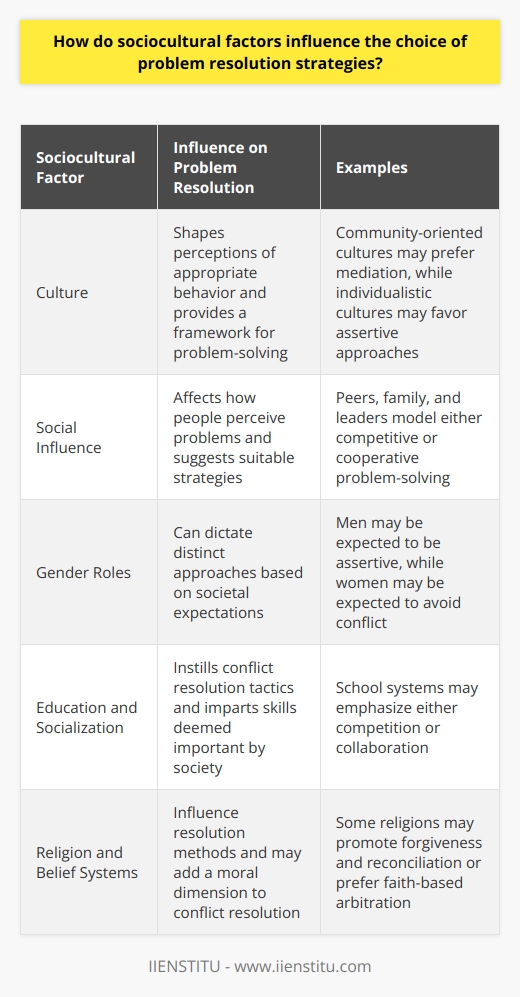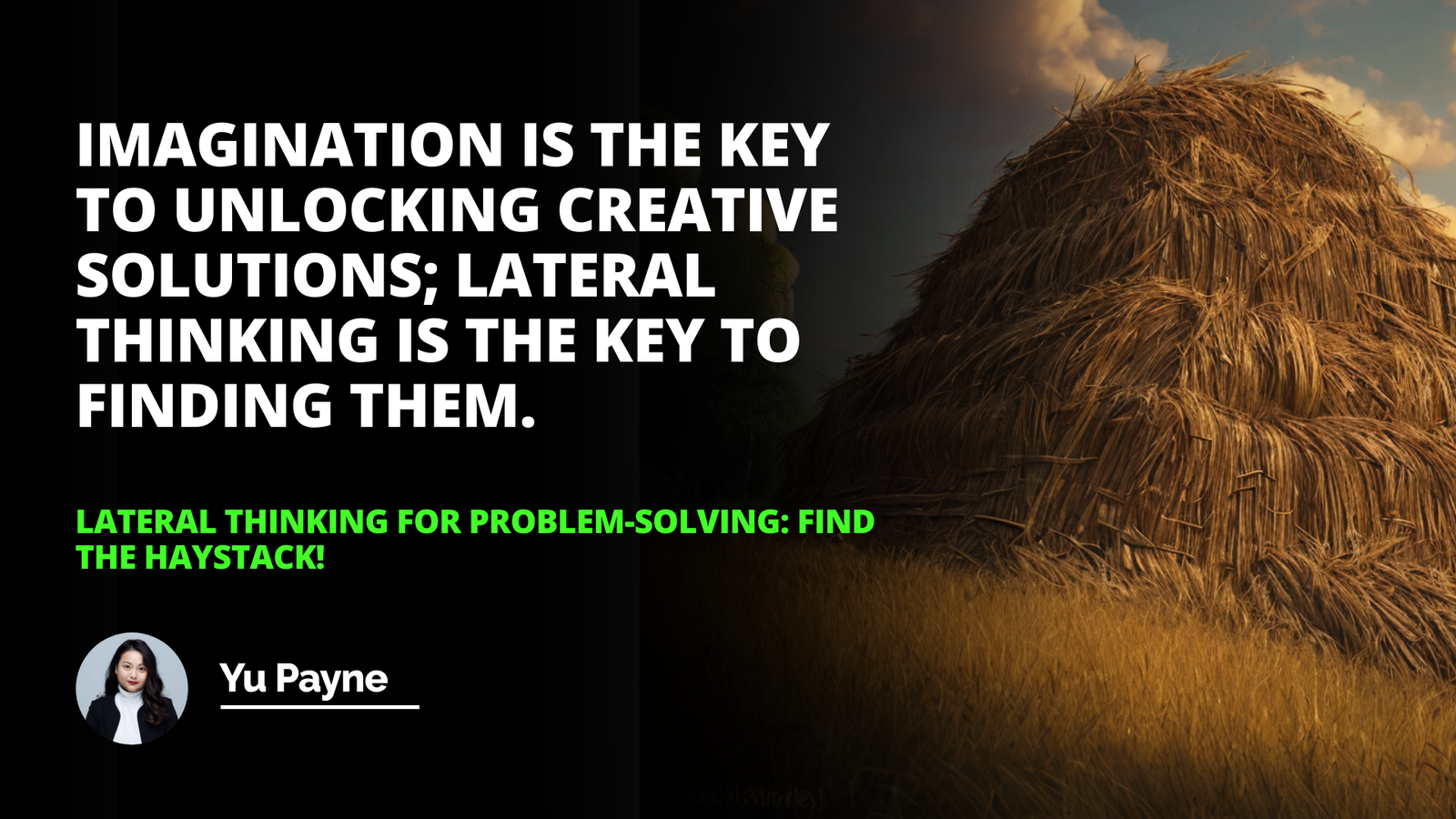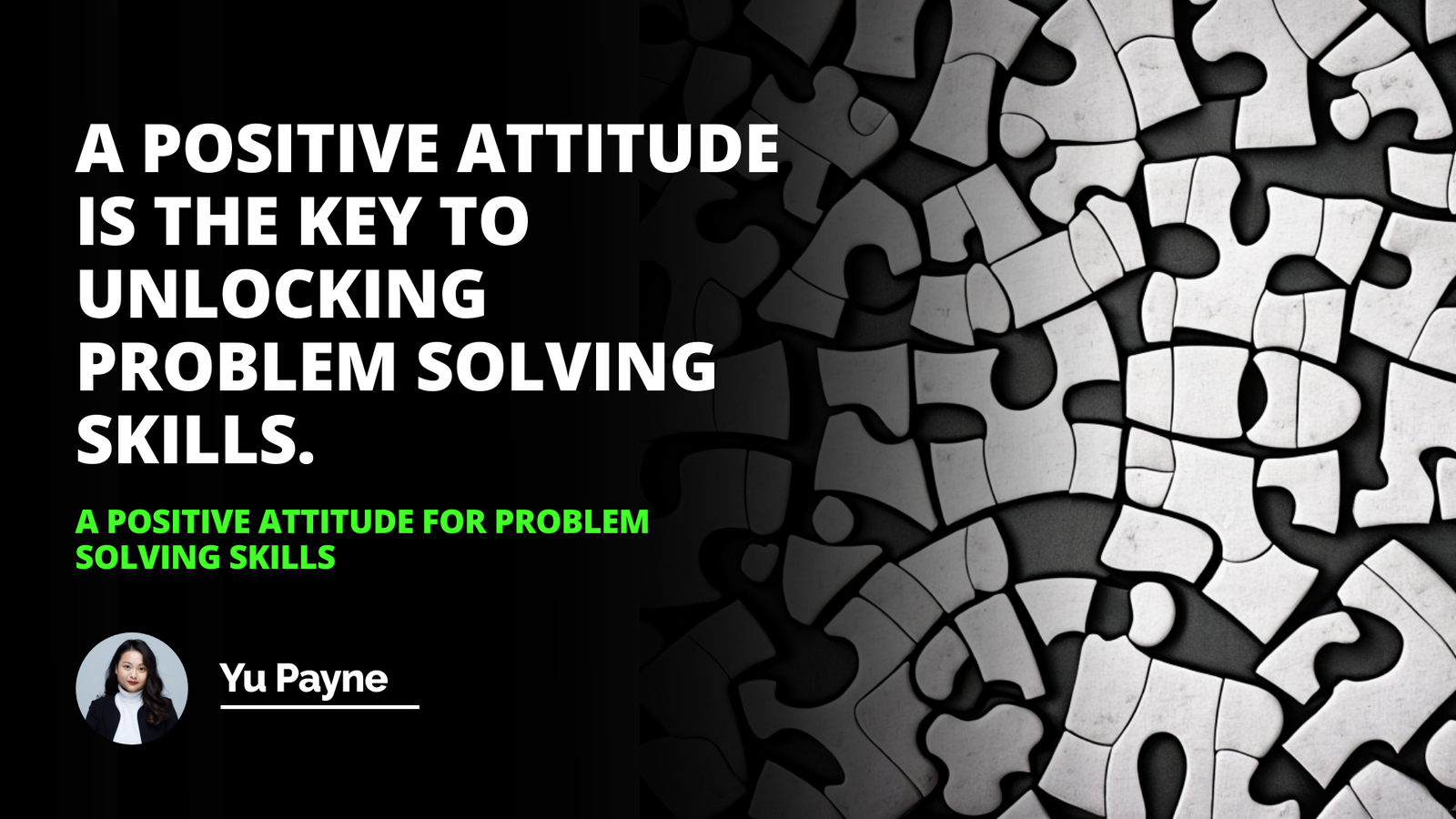
In the landscape of everyday challenges, the art of problem resolution stands as a pivotal skill, empowering individuals and organizations to navigate the complexities of diverse situations. This introductory exploration lays the foundational understanding of what constitutes problem resolution and underscores its paramount importance in various facets of life.
As someone who has faced numerous challenges throughout my personal and professional journey, I can attest to the transformative power of effective problem resolution. From resolving conflicts in relationships to tackling complex projects at work, the ability to identify, analyze, and resolve issues has been a game-changer for me.
Definition of Problem Resolution
Problem resolution can be thought of as both a process and a skill set—a methodical approach to identifying, analyzing, and resolving issues that impede progress or cause disruption. Central to this process is the capacity for critical thinking, which enables individuals to dissect problems and create effective solutions with a strategic edge.
I remember a time when my team was faced with a seemingly insurmountable obstacle during a crucial project. By employing a structured problem-solving approach, we were able to break down the issue, identify the root causes, and develop a tailored solution that not only resolved the immediate challenge but also prevented similar issues from arising in the future.
Importance of Problem Resolution in Different Aspects of Life
Be it in personal life, educational settings, or the business arena, the benefits of proficient problem resolution are manifold. The ability to confront and navigate obstacles not only fosters resilience and adaptability but also acts as a catalyst for learning and personal development.
In my own life, I've found that honing my problem-solving skills has been invaluable. From navigating complex family dynamics to overcoming academic hurdles, the ability to approach challenges with a strategic mindset has been a key driver of my personal growth and success.
Understanding the Essence of Problem Resolution
Brief Insight into the Concept of Problem Resolution
Delving into the essence of problem resolution involves an understanding of its multidimensional nature. It is an intellectual dance that balances analytical scrutiny with creative thinking, blending logical reasoning with intuition. Each problem presents its unique context and array of implications, necessitating an approach that is tailored yet flexible, structured yet fluid.
Different Types of Problems that Require Resolution
Problems are as diverse as the contexts in which they arise. They can be:
Simple or complex: A simple problem, such as a malfunctioning appliance, may require a straightforward troubleshooting approach, while a complex problem, like declining sales in a business, may demand a multi-faceted strategy.
Technical or emotional: Technical problems often have clear-cut solutions based on expertise and logical reasoning, while emotional problems, such as interpersonal conflicts, require a more nuanced, empathetic approach.
Immediate or chronic: Some problems, like a sudden IT outage, require swift action, while others, like improving company culture, may necessitate a long-term, sustained effort.
Importance of Identifying the Type of Problem
The accurate identification of a problem is a critical step in the problem resolution process. It influences the selection of tools and strategies and determines the path of inquiry and action. Misidentification can lead to flawed solutions, wasted resources, and additional issues.
I once witnessed a company implement a costly rebranding campaign to address declining sales, only to realize later that the root cause was actually a flawed product design. This experience taught me the crucial importance of thorough problem identification before jumping into solution mode.
Steps Involved in Problem Resolution
Identification of the Problem
Importance of Accurately Defining the Problem
The foundation of effective problem resolution is a clear, concise definition of the problem. A properly defined problem sets boundaries for the resolution process and provides clarity on what success looks like. Without this clarity, efforts can be misguided or dispersed ineffectively.
Techniques for Identifying Problems
Techniques such as root cause analysis, brainstorming sessions, and the five whys method are employed to peel back the layers of a problem and pinpoint the core issues. Effective communication also plays an essential role, allowing for various perspectives to surface and facilitate a holistic understanding of the problem.
Common Challenges in Problem Identification
Obstacles to problem identification often include cognitive biases, lack of information, and an over-reliance on assumptions. Overcoming these challenges requires an open-minded approach, rigorous questioning, and the gathering of sufficient data to inform the identification process.
Analysis of the Problem
How to Analyze a Problem Effectively
Once the problem is identified, the analysis begins with breaking down the problem into its constituent parts. This involves examining the underlying causes, the context, and the stakeholders involved. An effective analysis seeks to understand the problem in depth, paving the way for viable solutions to emerge.
Tools and Techniques for Problem Analysis
There are numerous analytical tools at one's disposal, such as:
SWOT analysis (Strengths, Weaknesses, Opportunities, Threats)
Fishbone diagrams
Flowcharts
These tools help in organizing information, revealing patterns, and illuminating the relationships between different elements of the problem.
Challenges in Problem Analysis and their Remedies
Challenges in this stage often stem from incomplete or inaccurate data, resistance to change from stakeholders, and preconceived notions about the problem. These can be mitigated by promoting a culture of transparency, encouraging diverse viewpoints, and committing to a thorough and unbiased analysis.
Project Management Strategies For Effective Decision Making And Planning
Developing Accurate Problem Solving Skills Techniques And Strategies
Setting up Possible Solutions
Formulating Potential Alleged Solutions
With a comprehensive analysis complete, the focus shifts toward generating a range of possible solutions. These should be diverse, creative, and practical, with an eye toward meeting the goals established during the identification and analysis stages.
Tools and Techniques to Aid Solution Formulation
Brainstorming
Lateral thinking exercises
Simulation models
Such techniques encourage out-of-the-box thinking and help to prevent the premature dismissal of innovative options.
Pitfalls to Avoid during Solution Formulation
During the formulation phase, it's critical to avoid tunnel vision or falling back onto familiar, yet suboptimal, solutions. Diverse teams, external consultations, and a willingness to experiment can combat these pitfalls.
Selection and Implementation of the Best Solution
Criteria for Selecting the Most Effective Solution
Selecting the best solution involves evaluating the proposed options against criteria such as feasibility, sustainability, cost, and impact. A thorough cost-benefit analysis often aids in this evaluation, ensuring a rational basis for decision-making.
I once had to decide between two software solutions for my company. By carefully weighing factors like scalability, user-friendliness, and long-term costs, we were able to select the option that best aligned with our needs and goals.
Steps to Implementing the Chosen Solution
Implementing a solution typically requires planning, resource allocation, and change management. Clear communication and the establishment of milestones are also crucial to tracking progress and maintaining momentum.
Common Challenges in Solution Implementation and Possible Solutions
Resistance to change, unexpected obstacles, and resource constraints are common challenges during implementation. Addressing these effectively may require adaptive leadership, stakeholder engagement, and contingency planning.
Review and Assessment of Implemented Solution
Importance of Reviewing Solutions
Once a solution is implemented, it is imperative to review and assess its effectiveness. This helps in confirming that the problem has been adequately resolved and provides insights for future problem-solving endeavors.
Tools for Solution Review and Assessment
Feedback surveys
Performance metrics
Review meetings
These tools provide quantifiable and qualitative data that inform whether the solution has met its intended objectives.
How to Leverage the Findings from the Review Process
Findings from the review process should be documented, analyzed, and communicated to all relevant stakeholders. This allows for continuous improvement and learning, honing the collective problem-solving capabilities.
Problem Resolution in Different Sectors
Business Sector
Role of Problem Resolution in Business
In the business world, problem resolution is crucial for survival and growth. It enables businesses to adapt to market changes, address client needs effectively, and optimize operations.
Real-life Example of Problem Resolution in a Business Setting
I once worked with a company facing intense competition in their industry. By engaging in a comprehensive problem-solving process, we identified key areas for differentiation and developed a targeted marketing strategy. This not only helped the company stand out but also led to a significant increase in market share.
Education Sector
Implication of Problem Resolution in Education
Educational institutions benefit greatly from problem resolution by enhancing the learning environment and addressing various administrative and operational challenges.
Example of Problem Resolution in an Educational Setting
As a teacher, I often employ problem-solving techniques to address individual student needs. By carefully analyzing each student's unique challenges and strengths, I can develop personalized learning plans that optimize their educational experience.
Personal Life
How Problem Resolution can Help Improve Personal Lives
In personal contexts, effective problem resolution can lead to more satisfactory relationships, improved financial management, and healthier lifestyles.
Personal Life Example where Problem Resolution was Effectively Applied
In my own life, I used problem-solving skills to navigate a difficult career transition. By assessing my skills, researching the job market, and developing a strategic action plan, I was able to successfully pivot into a new field that aligned with my passions and goals.
Conclusion
Recap on the Importance of Problem Resolution
Problem resolution is an invaluable skill with broad applications. Whether addressing personal, educational, or business challenges, its strategic application can lead to improved outcomes and promote an environment of continuous learning and adaptation.
Encouragement for Continuous Learning and Improvement in Problem Resolution Skills
In a world of ever-evolving challenges, investing time in honing problem resolution skills remains a prudent choice. Pursuing courses, learning from diverse scenarios, and incorporating reviews into every problem-solving cycle contribute to a robust skill set that can make a marked difference in any sector.
As I reflect on my own journey, I am grateful for the problem-solving skills I have developed over the years. They have been instrumental in helping me navigate the complexities of life and work, and have opened doors to opportunities I never thought possible. I encourage everyone to embrace the art of problem resolution, for it is a powerful tool that can transform challenges into stepping stones towards success.
Frequently Asked Questions
What are the key distinctions between different problem resolution strategies in conflict management
Understanding Conflict Management
Conflict management involves various strategies. Each caters to distinct situations and outcomes. Clarity on these differences enhances conflict resolution effectiveness. Here we dissect key problem-resolution strategies.
Competing Strategy
Competing involves assertive and uncooperative behavior. Parties pursue their interests, disregarding others. It echoes a win-lose situation. This method suits quick decision needs. But, it can damage relationships.
Accommodating Strategy
Accommodating contrasts with competing. Here, one party yields to another's needs. This approach values the relationship over personal victory. It works well for minor concessions. Long-term, it might cause resentment.
Avoiding Strategy
Avoiding indicates withdrawal from conflict. Parties neither address their concerns nor others'. This strategy buys time or deflects minor issues. However, avoiding can escalate unresolved conflicts.
Collaborating Strategy
Collaborating merges assertiveness with cooperation. Parties aim for a win-win solution. They search for options satisfying all involved. This intricate process fosters understanding. It requires time and trust.
Compromising Strategy
Compromising strikes a balance between competing and accommodating. Each party concedes somewhat. This method seeks a fast, fair solution. It may not satisfy everyone fully. Yet, it maintains relationships and progress.
- Competing: Quick, assertive, potentially damaging.
- Accommodating: Yielding, preserving relationships, can foster resentment.
- Avoiding: Detachment, temporary relief, might worsen later.
- Collaborating: In-depth, time-consuming, builds mutual respect.
- Compromising: Balance, moderately satisfies, preserves relationships.
Different conflicts need different approaches. Consider each strategy's impact. Align them with your conflict resolution goals. Effective management requires flexibility and discernment.
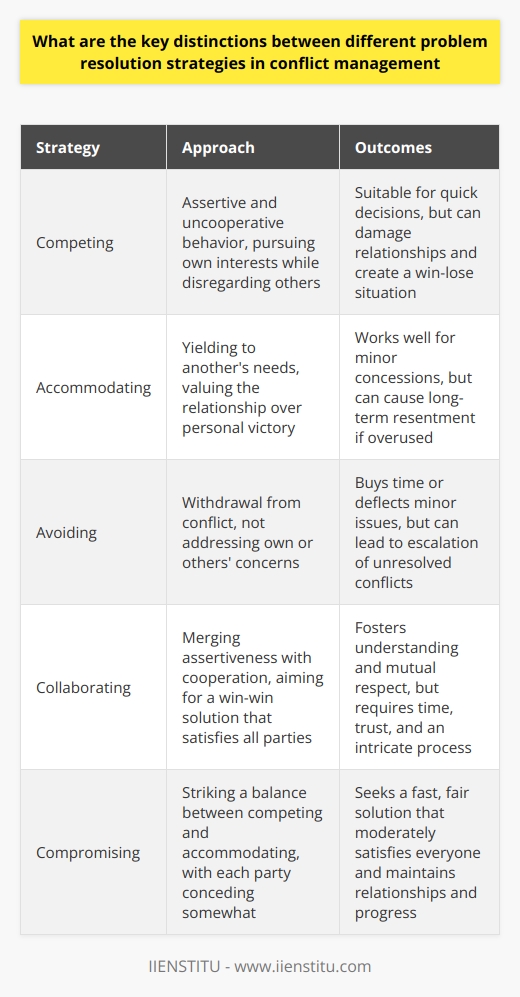
How can efficient problem resolution strategies impact organizational success
Efficient Problem Resolution in Organizations
Problem resolution strategies prove critical. They define organizational success. Poor methods can lead to failure. Efficient strategies, conversely, enhance performance. They streamline operations. They foster a healthier work environment. Most importantly, they drive growth.
The Impact on Performance
Efficiency reduces waste. It minimizes downtime. Efficient problem-solving speeds resolution time. It ensures continuity in operations. Critically, it increases customer satisfaction. Resolution speed often dictates customer retention.
Workers stay productive. They rely on effective systems. Such systems aid in problem-solving. Without them, frustration can ensue. This can diminish morale. Productivity usually suffers as well. Efficient strategies keep morale high. This improves overall productivity.
Operational Streamlining and Innovation
Efficient problem resolution demands process understanding. It calls for innovation. Organizations must constantly adapt. They must refine their approaches. Streamlining results from ongoing process improvement. This increases operational efficiency.
Such constant refinement leads to innovation. Workers become more proactive. They suggest improvements. They help refine processes. Organizations grow more competitive. They grow more agile. They better navigate market changes.
Creating a Positive Work Environment
Stress pervades problem-laden environments. Efficient strategies can alleviate it. They promote a positive atmosphere. Workers feel more empowered. They tackle issues confidently. This confidence promotes job satisfaction. It also fosters loyalty.
Team collaboration often improves. Colleagues work together. They solve problems. This cultivates a united workforce. It may also inspire leadership. Efficient problem resolution empowers workers. It creates leaders.
Driving Organizational Growth
Growth links to problem resolution. Efficient strategies enable scalability. They help meet increasing demands. They allow for expansion. Without them, organizations stagnate.
Customer trust hinges on issue management. Efficient resolution bolsters this trust. It encourages repeat business. It enhances the brand's reputation. Both are vital for growth.
Healthy financial management also depends on efficiency. Fast problem resolution saves money. It prevents costly delays. It preempts larger issues. It reduces the need for damage control. Financial resources can thus promote development.
Conclusion
Organizations thrive on efficiency. Efficient problem resolution stands central to this. It touches every aspect of an entity. It influences performance, morale, innovation, and customer relations. Ultimately, it shapes success. Organizations must invest in it. They must prioritize it. They must refine it. Only then can they solidify their place in the market.
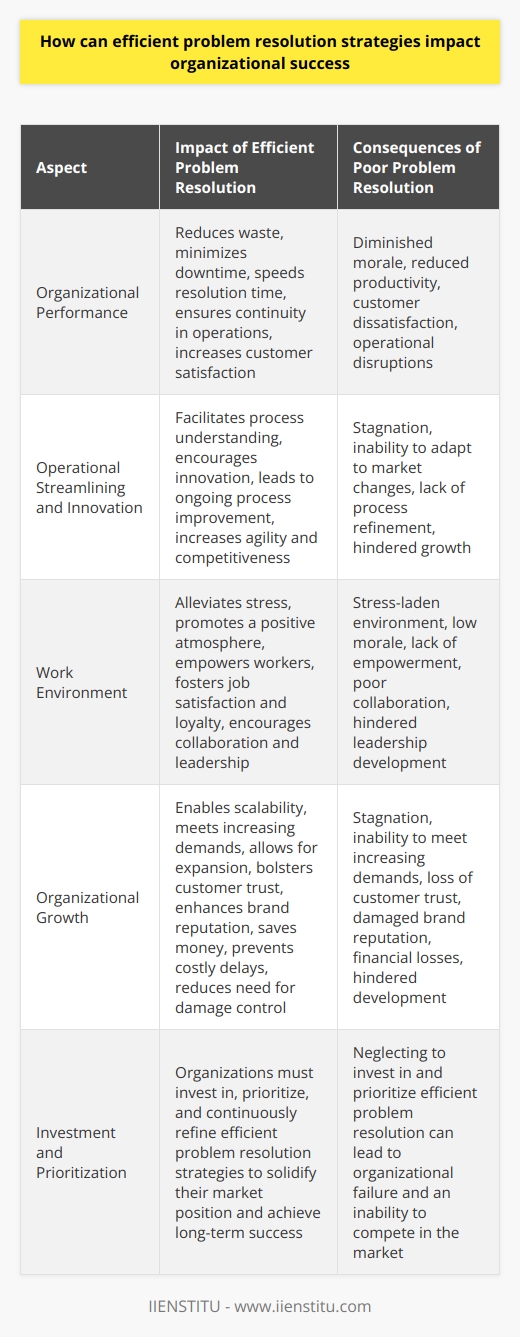
How do sociocultural factors influence the choice of problem resolution strategies?
Sociocultural Factors and Problem Resolution
Understanding culturally driven decision-making is complex. Societies differ widely. Individuals within them thus adhere to distinct norms. These norms often guide conflict resolution strategies.
The Role of Culture
Culture shapes perceptions of appropriate behavior. It provides a framework for problem-solving. Cultural protocols determine acceptable responses to conflicts. For example, some cultures value community harmony. Such values may promote mediation over confrontation. Meanwhile, individualistic cultures might stress personal rights. These societies often favor direct and assertive approaches. Egalitarian cultures might encourage collaborative strategies. Hierarchical societies might defer to authority figures.
Social Influence
Social influence is significant. It affects how people perceive problems. Peers, family, and leaders suggest suitable strategies. They model either competitive or cooperative problem-solving. Sociocultural norms dictate which influences are most potent. They also shape the cost of deviating from prescribed behavior.
Conflict Resolution in Context
Different contexts yield different strategies. Familial disputes might use conciliatory tactics. Workplace conflicts could necessitate formal mediation. Sociocultural context influences the resolution method chosen.
Gender Roles
Gender roles can dictate distinct approaches. Traditionally, societies expect men to be assertive. Conversely, women might be expected to avoid conflict. Such roles guide gender-specific resolution strategies. These expectations can hinder effective problem solving across genders.
Education and Socialization
Education instills conflict resolution tactics. School systems reflect the broader sociocultural values. They impart the skills deemed important by society. Children learn either competition or collaboration. The society's emphasis determines which skills are honed.
Religion and Belief Systems
Religious beliefs influence resolution methods. Religious tenets might promote forgiveness and reconciliation. In some religions, faith-based arbitration is preferred. These systems add a moral dimension to conflict resolution.
Economic Factors
Economic systems play a role. Capitalist societies might encourage competitive dispute resolution. Socially oriented economies might favor collective problem-solving. The economic framework often indicates the preferred approach.
Legal Systems
Legal systems embody sociocultural values. They often suggest formal processes. These processes can either be adversarial or restorative. Societies with strong legal traditions might favor structured resolution.
Conclusion
Sociocultural factors profoundly influence problem resolution. Understanding these influencers is vital. It ensures more culturally sensitive and effective approaches. Recognizing these nuances can lead to better outcomes in conflict resolution.
